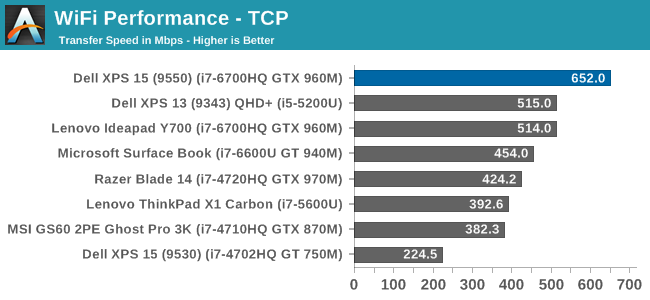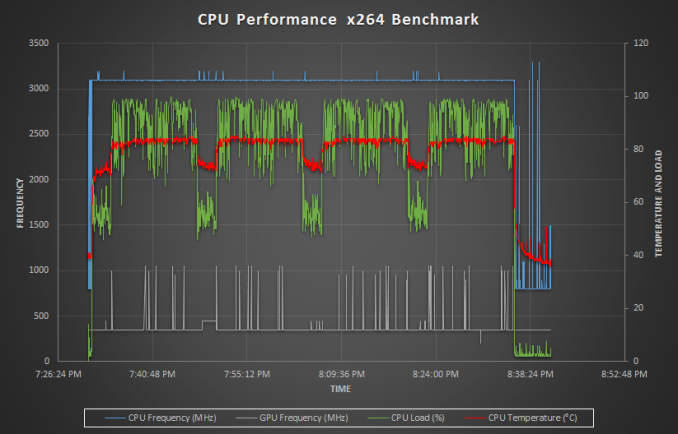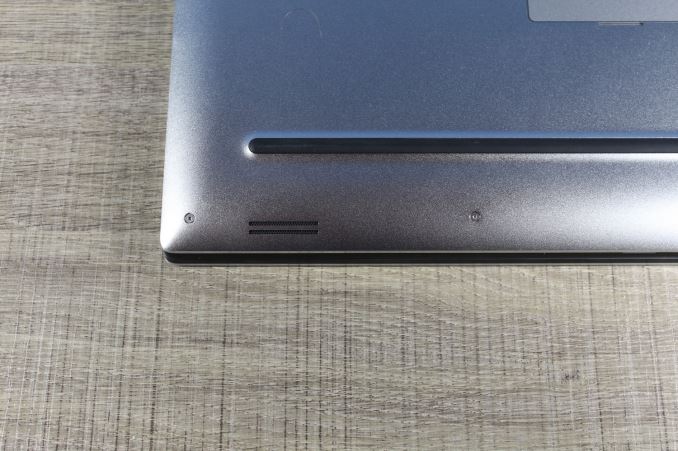The Dell XPS 15 9550 Review: Infinity Edge Lineup Expands
by Brett Howse on March 4, 2016 8:00 AM ESTWireless
The average laptop these days comes with a wireless card which can transmit and receive two spatial streams at once, and when it’s used with 802.11ac, that gives a maximum connection speed of 866 Mbps. The XPS 15 comes with a Broadcom wireless card which is 3x3:3, meaning it can work with a third spatial stream and has 50% more bandwidth available, which gives a maximum connection speed of 1.3 Gbps. Although on paper this is higher than Gigabit Ethernet, wireless rarely gets close to its maximum transmission speed whereas Gigabit Ethernet does. But assuming you have a router capable of 3x3 Wi-Fi, this solution should have a better shot of coming close to Gigabit Ethernet.

The XPS 15 sets a new AnandTech record on this test, beating out the Intel 8260 that only just jumped ahead on the last review. But to be honest I was expecting a bit better, if only because the 2x2 Broadcom solution could already hit 500 Mbps, so I was sort of expecting this to be over 700, but it’s still a good enough result that I didn’t feel like I needed to connect Ethernet when I was moving large files around on it, which isn’t something I can say about most laptops.
Thermals
When it comes to thermal considerations, shrinking the 15.6-inch form factor down, but still using higher performance (and therefore higher wattage) parts could be a concern. The CPU thermal design power is 45-Watts, and while NVIDIA doesn’t disclose the mobile GPU TDPs, it’s likely around 60-Watts or so. In most cases, GPU intensive workloads are not too hard on the CPU, and that’s true the other way as well. Laptop gaming, for instance, is very heavy on the GPU but generally not as taxing on the CPU, so in most scenarios Dell won’t have to remove the entire combined TDPs of both parts.
To test the CPU performance with a heavy and long duration workload, I logged the frequency and temperature of the CPU while running the x264 benchmark, which takes about an hour and runs the CPU near 100% load for the duration. As you can see, there was no thermal throttling at all in this workload, but the CPU certainly got warm, peaking around 84°C.
To test the GPU, I looped the Tomb Raider benchmark for about an hour, logging the GPU data every second. As with the CPU test, there was no thermal throttling of the GPU despite the heavy load and long duration. The GPU temperature never got over 79°C during this test.
Dell did a nice job on the cooling solution for the XPS 15. Despite the smaller chassis, it doesn’t appear to throttle under these workloads.
Noise
The other side of the cooling is noise. It’s an unfortunate side effect that in order to remove the heat, we have to rely on fans, and laptops with quad-core processors and GPUs are going to need fans. As with most laptops, the XPS 15 can disable its fans completely when lightly loaded, allowing quite operation, but once you do start to do some work, the fans slowly ramp up, starting around 36 dB(A) and going all the way up to 41.9 dB(A) on sustained light workloads. The XPS 15 can be silent, but once the fans kick in they are certainly audible.
Under heavy loads, the XPS 15 is, to put it bluntly, loud. I measured 52.7 dB(A) with the SPL meter 1” over the trackpad. This was after the GPU load test, where Tomb Raider was left running for over an hour. As a comparison, the Lenovo Y700 with the same CPU and GPU, and doing the same test, was closer to 44 dB(A) after the hour, and since decibels are logarithmic, that’s a big difference. This is the down side of a slim and light form factor: the fans are louder.
Audio
The XPS 15 has two speakers on the bottom of the laptop near the front. I measured 90 dB(A) from the speakers playing music, which makes this one of the loudest laptops I’ve seen. The sound quality is typical of a laptop, with not a lot of range and a lack of low end response.













152 Comments
View All Comments
milli - Friday, March 4, 2016 - link
I'm having huge stability problems with this laptop. The problem is Optimus.The only way I've gotten it to be stable, is to use the Dell provided drivers and disable Optimus.
I'm not the only one with this problem:
https://www.reddit.com/r/Dell/comments/41erin/blue...
This laptop badly needs a BIOS update to fix this issue.
smilingcrow - Friday, March 4, 2016 - link
I give leeway for photos as I know it's not easy photographing electronics at home if you have no experience but these would look bad even on eBay. Don’t recall feeling that way about any other photo shoot on any IT web review so this is a stand out.Is it too much to expect Anandtech to issue guidelines and tips for newbie photographers? I don’t think so. Amateur hour.
theduckofdeath - Saturday, March 5, 2016 - link
Hehe, that was my thoughts, too. "Dell sticks to their proven design ideas from the XPS 13" (paraphrased). Too bad we'll never know what that is.close - Monday, March 7, 2016 - link
Were you just piggy backing on a BIOS/performance related comment with a remark about photography just to get attention? I would say you give no leeway for photos which is why probably you've run out of people who's vacation photos you can criticize and ended up here :).On a related note, I wonder if the battery performance is strictly related to the choice of LCD panel. And since we're on the battery topic, I'm really impressed with the WiFi speed. It's starting to look like we're closer to moving away from wired connections completely.
milkod2001 - Monday, March 7, 2016 - link
I presume guys who write articles here are paid by amount of words/articles written and not by hours spent with camera and Photoshop.By looking at mostly poor quality of images it does not look like PURCH has given each writer a few grand for camera, lenses, accessories and guys probably just use their own crappy stuff.
Since Anand and others have left it looks like there is still big afford to write good quality articles. But other stuff coming with it goes down to hill and there is a very little improvements if any.
Just to name a few: the endless and never responded request for EDIT button for comments, some amateurish never fixed website 'features' like galleries -you click on some images, it will bring user to new tab(unnecessary) , click on some image, it will display large image and nothing else, no X or back button etc.
dsumanik - Sunday, March 6, 2016 - link
5 years ago anandtech would have tested and caught a bios issue like that, now the readers are more informed lolclose - Monday, March 7, 2016 - link
You have 3 available CPUs, 2 GPU configurations, 2 LCD panels, and different software configuration possibilities but you instantly assume that all laptops exhibit the exact same issues and they will be visible on a demo unit in the days or weeks it's available for testing.The link to the discussion about this issue includes a handful of comments and if you had the common sense to read them you would have seen that plenty of them suggest that it was fixed by using the Nvidia driver provided by Dell. Since this is a review, not a troubleshooting article I suggest you should not confuse it with a manufacturer support page.
And people could tell the difference 5 years ago.
milli - Monday, March 7, 2016 - link
No Close, all models exhibit BIOS problems. Optimus is just the latest. Before BIOS 19, there were a bunch of other issues.http://bit.ly/21gI00Z
http://bit.ly/1QZFIO8
After spending close to $3000 on a laptop, I'm very disappointed in Dell as they can't get even something like Optimus running stable.
close - Monday, March 7, 2016 - link
What I was saying was directed to the person claiming Anandtech should have reported this in the product review when clearly it doesn't affect every laptop and also I'm quite sure reviewers only have a narrow time slot to play with the device before it goes on to the next reviewer.And I maintain my suggestion for him since he appears to think such issues should be reported in a product review: the manufacturer's support site is the place to go if you're wondering how a product behaves in the long run.
Anandtech is the place to read reviews about a product, standardized tests run on every piece of hardware and some numbers that you can't find on the leaflet.
A review isn't made to showcase beautiful photos like some people seem to think (that's the job of the product marketing team) nor to listing a long line of potential issues compiled from support sites and other forums.
So I understand *you* were just cautioning potential buyers reading this review, the comment from "dsumanik" (just above) is plain ignorant to put it delicately.
dsumanik - Monday, March 7, 2016 - link
I stand by my original statement, the readers around here are now more informed than the editorial/review staff. No amount of excuse making will change this. In the past Anand (the person) worked with manufacturers on a regular basis to identify and correct issues like the one pointed out with this machine. We will never hear of a resolution to this problem on this website, unless it is in the comment section. And yes, if you are in the business of reviewing products, it IS your responsibility to investigate the issue...a simple check on the forums and a warning paragraph would have sufficed, you'd think the reviewers would haver a checklist to follow by now lol.